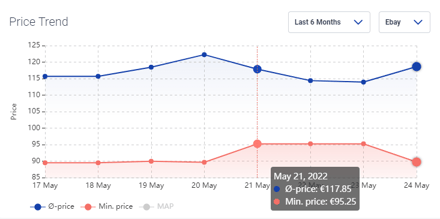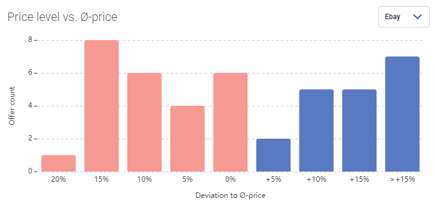Over the last two decades, as the growth of e-commerce has propelled the retail industry forward, a parallel trend has taken shape: The rise of the grey market or parallel market. The expansion of online stores like eBay and Amazon in the early 2000’s allowed for unauthorised resellers of the premium and luxury segment to take place, and at times having only negative effects on the brands they trade, the customer and the industry as a whole.
The grey market is a sector that has operated out-of-sight from most consumers but is now taking centre stage in many consumer baskets. An estimated 8% of the €243 billion personal luxury goods market is grey. For instance, if you are looking for a pair of Ray Ban aviator sunglasses, the price is €145 on ray-ban.com. However, with a simple search on our PriceTracer platform, we found the product for the average price of €118 over all offers. From 44 vendors, 25 of them are selling this product for below the average price.


Grey-market activities mainly cover two scenarios: Unauthorised third-party resellers will import a product in bulk, usually from a different market and then resell it on their online store. The second scenario features retailers like Amazon and Alibaba, whereby smaller retailers use their platform as unauthorised third-party resellers.
In both cases, most have no official partnership with the brand they’re retailing and as it is most often high-end items such as designer clothing, high-end skincare and makeup, sporting brands there is a huge demand.
In Germany, a top global fashion brand has 11 official, authorised resellers, however, our PriceTracer service detects 130 vendors nationwide. This means this particular brand within Germany has a grey market size of 91.5% compared to a much smaller pool of authorised sellers of 8.5%. In other cases, brands may not be aware of the size of their grey market pool.
Defining grey and black markets and counterfeit goods
There are two key aspects that often get muddied when looking at grey markets, namely the differences in counterfeited vs unauthorised products.
- Grey market activity refers to the unauthorised distribution channels where branded products are traded. The product is the real, however, it’s the unauthorised distribution channels that make it part of grey market activity.
- Black markets are more sinister. Black market activity includes items that are illegal to manufacture or sell. This includes both counterfeit and genuine products. Examples of black market items are exotic or protected wild animals, illegal drugs, weapons or human organs for illegal transplants.
- Counterfeited goods are fake products attempting to mimic the real thing. Sellers of counterfeit goods usually sell these items at a lower price point in a market that would typically not be subject to this brand’s retail strategy. Similar to some of the counterfeit makeup, electronics or sports brands sold at street markets around the world.
How a product’s final price is comprised
There are a number of pricing strategies that brands and retailers may use to come up with a specific number, including competitor-based pricing, cost-plus pricing, value-based, penetration, price skimming, target costing and of course dynamic pricing where everything mentioned above can even converge.
Whichever one is used, the end price involves a delicate algorithm balancing the cost price, projected profit margins, inflation, marketing, logistics, employees and the market. Authorised sellers have access to and are part of the chain that links all the costs within a price together. Grey market sellers do not, on the other hand. So, when grey market sellers choose to sell a brand’s product at a much lower or higher price, it has a negative ripple effect on the brand, its customers and the market.
Talk to one of our consultants about dynamic pricing.

What are the ways in which brands, retailers, customers and retail as a whole are affected?
Sales and margins decrease
In 2016, a report by KPMG showed that the estimated value lost by products being sold through unauthorised sellers in the US amounted to $58 billion. Six years on, running parallel to the rise of e-commerce that number has surely increased. The most immediate and obvious impact is the effect on sales and profit for the brand itself as well as their manufacturers and authorised resellers. If a grey market reseller sells a product - like a pair of Nike running shoes - closer to cost price, authorised resellers will take the knock. As the grey market reseller has thickened the competitiveness by providing the exact same product at a lower price.
Customers lose certain benefits
Knowingly or not, if a customer buys a product from a grey market seller, there are certain things they may not receive that they would if they had chosen an authorised seller. Firstly, there is no 100% guarantee that this product is authentic. Because of the informality of the grey market industry, you cannot be absolutely certain that what you’re getting is not a knock-off product.
Secondly, there are often no return policies like with most established retailers. If a product like a shoe or a dress doesn’t fit the way you’d like, you can't necessarily return it. Lastly, there is very little in the realm of customer service as one would receive going into a store or using the online chat feature in the brand or approved e-commerce outlet.
Brand identity takes a knock
A brand often chooses specific retailers to resell their product. For example, ASOS is an authorised reseller of Adidas. Smaller, lesser-known retailers may purchase Adidas products in bulk and start selling them on a lower price level than average without Adidas’ knowledge. This retailer may also be on the other end of the spectrum when it comes to identity and aesthetic, which can be hurtful to the brand.
It is not without reason that premium brands spend a lot of money on marketing campaigns, sponsorships and events to establish a particular image in the market, which is also reflected in a certain price level of its products. Brands select authorised retailers with care that are aligned with their goals, and if a grey market seller attempts to jump on the bandwagon, it could negatively impact brand identity.
Customers lose trust in the brand
Grey market activity also affects the home electronics industry, with a number of global electronics and smartphone brands falling victim to copy cat merchandise. It is no surprise then that customers thinking they’ve purchased the real thing will be disappointed and rightfully disgruntled when the product stops working after a few weeks, or not at all. Customers - who unknowingly bought electronics from grey market sellers - will lose faith and trust in the brand’s product and overall stature in the market.
How can brands fight against grey market resellers?
Educating customers about buying from authorised sellers through their advertising and marketing strategies is not a fireproof way to get the message across to customers, but it is a start.
Some brands have begun to use brand-specific stickers or tags on products to show that only legitimate products from authorised sellers will have these stickers or tags. Others are using tracking codes to see where products are going, which country they may be shipped off to and if a bulk amount was purchased.
However one of the best ways to take action is to simply monitor your brand and the pricing in the market, if there are periods when the price takes a dip you will be first to know and possibly take action.




.png?height=766&name=Untitled%20design%20(21).png)